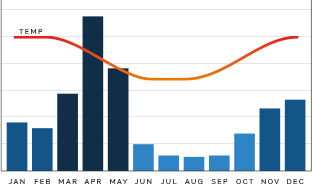Xi'an is more than 3000 years old and served as a capital of this region of China for more than 1000 years. These days it is famous for the terracotta warriors that were discovered here during the Cultural Revolution.
Xi'an is such a major player on the Chinese tourist trail that there is a saying; 'if you haven't been to Xi'an, then you haven't been to China'. The city of Xi'an has many other interesting sites confined within its old city walls.Things to see and do:
The Terracotta Warriors are located just outside the new city and were discovered by accident in 1974 by a farmer. The site contains over 7000 terracotta warriors and horses all lined up to protect the tomb of the First Emperor of unified China, Qin Shi Huang. His mausoleum stands close to where his terracotta army were found, but has not been opened as of yet. The adjacent museum contains an incredible array of the best statues, weaponry and armour on show. Outside, you too can buy your own small piece of history from the local vendors who sell a collection of small copies of the warriors. The old City Walls are one of the highlights of modern Xi'an, built in 1370 during the Ming dynasty, with a perimeter of 14km. It is possible to cycle around the walls and bikes can be rented quite easily within the city (beware though, the top is a little slippery when it rains), alternatively you can enjoy them in four hours of very comfortable walking.
The Muslim Quarter and Great Mosque are both found inside the city walls; this area has been home to the Hui community for a few centuries now, and it is well worth a venture here both by day and by night to soak up the amazing atmosphere and taste some Chinese Muslin cuisine. The narrow streets are full of small shops, factories, mosques and local restaurants - it's an intriguing place to visit. The Great Mosque, one of the largest in China, is also worth a look, especially for its unique blend of Chinese and Islamic architecture and its central minaret disguised as a pagoda, to fit in with the surroundings.
The Terracotta Warriors are located just outside the new city and were discovered by accident in 1974 by a farmer. The site contains over 7000 terracotta warriors and horses all lined up to protect the tomb of the First Emperor of unified China, Qin Shi Huang. His mausoleum stands close to where his terracotta army were found, but has not been opened as of yet. The adjacent museum contains an incredible array of the best statues, weaponry and armour on show. Outside, you too can buy your own small piece of history from the local vendors who sell a collection of small copies of the warriors. The old City Walls are one of the highlights of modern Xi'an, built in 1370 during the Ming dynasty, with a perimeter of 14km. It is possible to cycle around the walls and bikes can be rented quite easily within the city (beware though, the top is a little slippery when it rains), alternatively you can enjoy them in four hours of very comfortable walking.
The Muslim Quarter and Great Mosque are both found inside the city walls; this area has been home to the Hui community for a few centuries now, and it is well worth a venture here both by day and by night to soak up the amazing atmosphere and taste some Chinese Muslin cuisine. The narrow streets are full of small shops, factories, mosques and local restaurants - it's an intriguing place to visit. The Great Mosque, one of the largest in China, is also worth a look, especially for its unique blend of Chinese and Islamic architecture and its central minaret disguised as a pagoda, to fit in with the surroundings.


